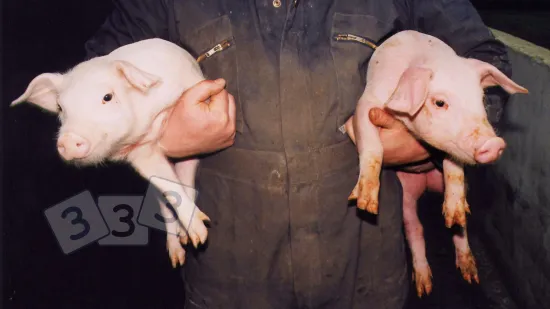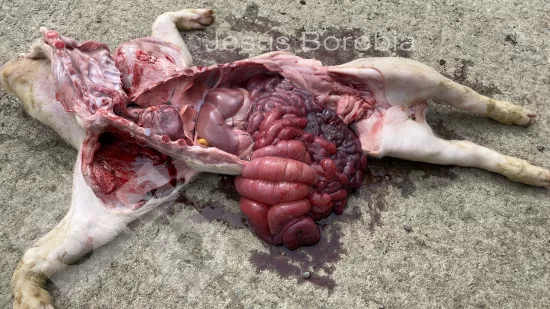Week of 12-Feb-2025
There is scour, ill thrift and high mortality during the first 4 weeks post-weaning. All post-mortemed pigs had the same gross lesions, as the one seen in the picture. What is the most likely cause of this lesion?
E. coli with a virulence factor F18 was detected by RT-PCR in this pig.
E. coli is a common inhabitant of the intestine of the pig. At weaning time the loss of sows milk and IgA allow the E. coli to attach to the villi of the small intestines, the toxins cause acute enteritis and diarrhoea. Post-weaning diarrhoea is a common cause of mortality and morbidity. Zinc Oxide had been removed from the weaner diet. These weaner pigs did not have any medication in feed or water. The inclusion of Zinc oxide and medicating the water with colistin helped to resolve the problem. Zinc Oxide in the peri-weaning diets improves pig health and acts as a growth promoter. It prevents diarrhoea and post-weaning enteric disturbances greatly.
Photo of the week

Week of 26-Nov-2025
What pathogens are involved?

Week of 19-Nov-2025
The weaner pig on the left is pale when compared with a normal weaner on the right. These pale pigs are slow growing. What is the cause of the problem in this case?

Week of 12-Nov-2025
These piglets are stunt with distended abdomens. The perineal area in these pigs is abnormal at inspection. What is the cause of this condition?

Week of 05-Nov-2025
Which lesions are present in this lung?

Week of 29-Oct-2025
What is the name of this parasite?

Week of 22-Oct-2025
This image of a cross-section of a pig lung is characteristic of a pneumonia caused by:

Week of 15-Oct-2025
What could be causing these lesions?

Week of 08-Oct-2025
Most of the pigs in this pen have dark coloured over the skin. What is the cause of this condition?

Week of 01-Oct-2025
A number of weaners died suddenly within the first 4 weeks post-weaning. All them have oedema of mesocolon at post-mortem examination. What is the most likely cause of this lesion?

Week of 24-Sep-2025
Which pathogen causes this lesion?

Week of 17-Sep-2025
What lesion is seen?

Week of 10-Sep-2025
Some pigs have swollen ears and walk with their heads tilted to one side. What is the most likely cause of this lesion?

Week of 03-Sep-2025
A piglet is born alive with 6 legs. What is the cause of this finding?

Week of 27-Aug-2025
Some finishing pigs are found with swelling of the tails with blood. What is the cause of it?

Week of 20-Aug-2025
Some gilts and sows have died suddenly during the last few months with no apparent clinical signs of disease. There is haemoperitoneum and splecnomegalia at post-mortem examination. What is the cause of mortality?

Week of 13-Aug-2025
A carcass is split in half and an abscess is found in the spine and burst. What is the cause of this lesion?

Week of 06-Aug-2025
Many sows have abscesses in the side of the neck. What is the cause of this lesion?

Week of 30-Jul-2025
What lesion is seen in this image?

Week of 23-Jul-2025
A sow is found with skin lacerations in the pen. What is the cause of this condition?

Week of 16-Jul-2025
A number of finishing pigs have ulcerative pododermatitis on the lateral side of their feet which causes lameness. What is the cause of this lesion?

Week of 09-Jul-2025
There is an increase of ill thrift and laboured abdominal breathing in 6 to 8 weeks old weaner pigs. There is poor response to antimicrobial treatment. Mortality has increased from 1.5% to 6%. Post-mortemed pigs had interstitial pneumonia. What is it?

Week of 02-Jul-2025
Necrotic hepatitis with hepatic parenchyma infiltrated with gas bubbles is detected in a sudden dead sow during post-mortem examination. What is the most likely cause of this lesion?

Week of 25-Jun-2025
A lactating sow is found with widespread raised rhomboid lesions on the skin. What is the most likely cause of this lesion?

Week of 18-Jun-2025
This sow had poor body condition, was anaemic and was found dead in the pen. The stomach had a dark black content inside. What is the most likely cause of this lesion?

Week of 11-Jun-2025
There is bloody diarrhoea and mortality in 3 days old piglets. The small intestine of post-mortemed piglets is dark red, haemorrhagic and filled with bloody fluid. What is the most likely cause of this lesion?

Week of 04-Jun-2025
There is profuse yellowish scour, ill thrift and high mortality during the first 72 hours of life. What is the most likely cause of this condition?

Week of 28-May-2025
An outbreak of sudden deaths and coughing is detected in 10 weeks old pigs. Post-mortem examination detects necrotizing pneumonia with fibrinopurulent exudate of the peritoneal and thoracic cavities. What is the most likely cause of this lesion?
